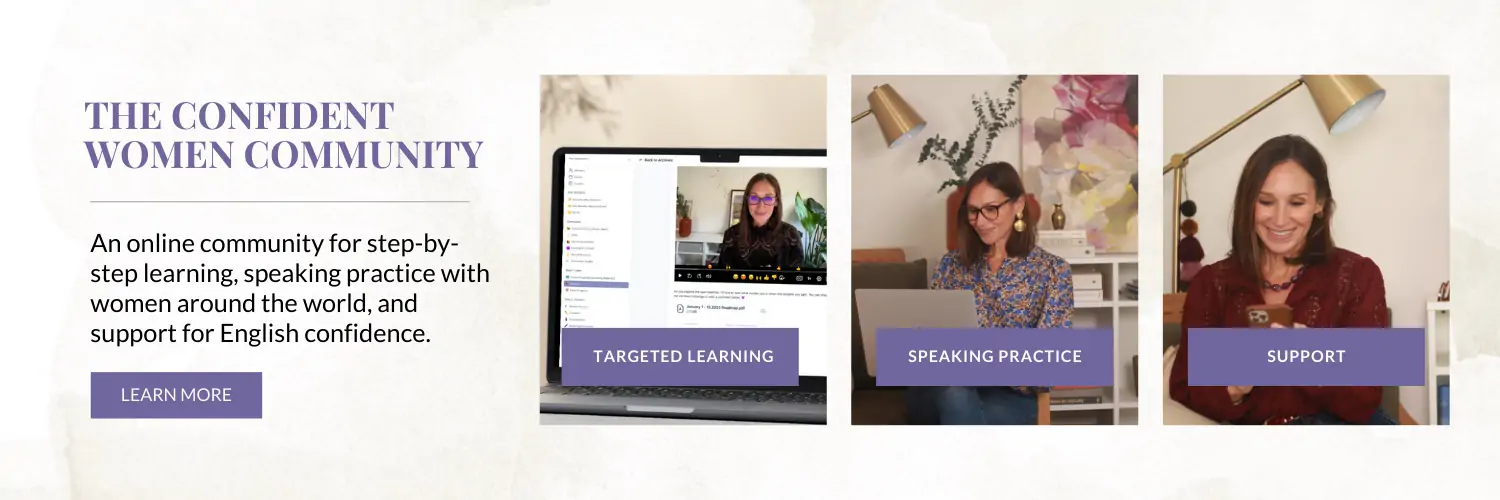#296: 12 Irreversible Word Pairs for Precise Communication [+ FREE Worksheet]

- Give and take
- Safe and sound
- Live and learn
- Push and pull
- Ebb and flow
These wonderful word pairs are what we call “binomial pairs” — very jargony, I know.
They’re also known as irreversible binomials or irreversible word pairs. You might even hear frozen word pairs.
So, are they important?
Well, that’s debatable.
Truthfully, I have English conversations every day without these frozen word pairs. So they aren’t necessary for daily, basic conversation.
However, once you know them, you realize they’re perfect.
Sometimes, you want to say something complex or difficult to explain. And if you have the right word pair, then all you need are those 2 words. It’s beautiful.
I can tell you that the last one on the list — ebb and flow — has become a favorite with women in my Confident Women Community — my online community designed for targeted learning, English-speaking practice, and support.
Today, I want to introduce you to 12 of these irreversible word pairs in English — and in my opinion, they’re fantastic to add to your English vocabulary.
Plus, I have a PDF you can download with a practice activity today. 🙌 You can get it below.
12 Irreversible English Word Pairs You Should Know | English Vocabulary
What does it mean for these word pairs to be irreversible?
- Also known as binomials, these are pairs of words that are linked together by prepositions or conjunctions.
- They are commonly used together in a specific order that NEVER changes. When they’re reversed, the meaning is lost, and the pair sounds awkward.
If you don’t need them for basic conversation, then why are they important?
Learning and knowing irreversible word pairs means you can
- Speak with clarity and precision because they help you communicate more effectively and avoid wordiness
- Add to your idiomatic library in English, improving your comprehension of English conversations and overall fluency
- Be more culturally aware of English by understanding the nuances of these English word pairs
- Have elevated professional communication with these word pairs which are often used in academic papers and business documents
- Better understand literature and even poetry because binomial pairs are often used to create rhythm or to convey specific images and emotions
And finally, where and when are they used?
These word pairs are commonly used in any and every situation.
English speakers will use them in:
-
- Negotiations;
- Job interviews;
- Customer service;
- Small talk;
- Medical appointments;
- Parent-teacher meetings;
- and, more!
To simplify this lesson, I’ve divided today’s 12 binomial pairs into 3 categories:
Category #1: Describe Movement & Directions
Category #2: Describe Choices & Decisions
Category #3: Describe Life Experiences & Relationships
Category #1: Describe Movement & Directions
English speakers often use the following word pairs when describing movement, both literal and figurative:
- Here and there
- Def: in different places; a series of undefined or unspecified places
- Ex. “When I travel, I like to go here and there.”
- To and fro
- Def: back and forth; moving in both directions
- Ex. “Eliza walked to and fro in her living room as she thought about moving to another city.”
- Ebb and flow
- Def: The natural up and down movement or change in something, like the tide in the ocean.
- Ex. “The success of a business often ebbs and flows, with challenging periods in between.”
Category #2: Describe Choices & Decisions
In addition, native speakers often use irreversible word pairs when describing choices, decisions, expectations, or attitudes.
- Push and pull
- Def: to be caught between two forces and be indecisive between two opposing options or feelings.
- Ex. “Jane felt a push and pull within herself as she thought about whether to follow her passion for painting or continue her stable job as an accountant.”
- Dos and don’ts
- Def: rules or guidelines that define what’s allowed and what’s not allowed
- Ex. “Before we move forward, HR would like to discuss the dos and don’ts of requesting time off through the online portal.”
- All or nothing
- Def: used to describe a situation in which one must fully commit or not at all
- Ex. “In sales, it’s almost always all or nothing; we either meet our targets or fail to make a bonus.”
- Sink or swim
- Def: used to describe a situation in which you must either succeed on your own or fail without help.
- Ex. “When you start a new job, you often have to adapt quickly and learn the ropes on your own; it’s a sink or swim situation.”
Category #3: Describe Life Experiences & Relationships
Finally, we use irreversible word pairs when talking about daily life events, the relationships between people or things, and when describing experiences.
- Here and now
- Def: at this moment; immediately
- Ex. “If you want to have a healthy lifestyle, make small changes here and now.”
- Give and take
- Def: a situation in which people agree to compromise and make concessions to meet each other’s needs
- Ex. “A healthy friendship involves give and take.
- Similarly, “In any negotiation, there’s a bit of give and take required.”
- Safe and sound
- Def: Completely unharmed, secure, and safe.
- Ex. “After the storm, we were relieved to find our relatives safe and sound inside the house.”
- Live and learn
- Def: to gain wisdom or understanding from one’s experiences and mistakes as one goes through life.
- Ex. “I made a mistake on my project, but I’ll live and learn from my errors.”
- This and that
- Def: used to refer to various things without explicitly specifying.
- Ex. “We looked at this and that while at the store, but didn’t buy anything in the end.”
For extra practice, download my FREE PDF Worksheet.
And if you have questions or would like to share your own example sentences using these word pairs, you can share them directly with me in the comments below.
~ Annemarie

Get the Confidence to Say What You Want in English
Follow my 3-step solution to speak English with clarity, fluency, and freedom so you can say what you want with confidence.
You'll also get my Confident English lessons delivered by email every Wednesday and occasional information about available courses. You can unsubscribe any time.
More Like This
#338: Better Ways to Say ‘Speak’ in English | Advanced Verbs
Struggling to describe how someone speaks in English? Try these 28 powerful synonyms to express emotion, tone, and voice like a fluent speaker.
Have To vs. Need To vs. Must – What’s the difference in English?
What’s the difference between have to, need to, and must in English? Learn how to use these modal verbs for obligation with confidence and clarity.
8 Expert Ways to Use “Could” in English | Grammar Lesson for Real Conversations
Learn 8 expert ways to use could in English—past abilities, polite requests, regrets, and more—with real examples and clear practice tips.
#337: English Reading Practice to Be More Fluent | Proven Steps
Use English reading practice to be more fluent. Learn how to remember vocabulary, improve grammar, and speak English confidently in real conversations.
#336: English Conversations on How Much and How Many | Advanced Vocabulary
Struggling to describe amounts naturally in English? If you keep using “some” and “a lot” in conversations, you might sound repetitive or unclear. In this lesson, you’ll learn precise, natural English expressions to talk about how much and how many.
How to Say No in English Politely (Without Feeling Guilty)
Struggling to say no without guilt? Learn how to say no in English politely—at work and in social situations—without stress. Get confident, professional phrases to refuse requests clearly and kindly.
© Copyright 2014-2025 Speak Confident English | Privacy Policy | Terms & Disclaimer | Online Class Policies







Hi Annemarie , Here are my examples When I travel on holiday I prefer go here and there.I reserve only the flight and the first day at the hotel …. after all is to and fro in the country … As a character I don’t like compromise and sometimes I feel as Push and pull When I heard people speaking about the relations I noticed that there is rather all or nothing then give and take …. Surprisingly the globalization has made us more selfish. My grandmother was a fantastic example of swimm or sink .The life faced her to… Read more »
Thank you so much for sharing your examples, Luisa. You have some great ones here.
I have 1 or 2 I’d like to clarify. Can you tell me what is ‘to and fro’ in the country. Do you mean that you like to travel ‘to and fro’ when visiting a new country?
With “As a character I don’t like compromise and sometimes I feel as Push and pull…” are you indicating a character trait or personality trait? When you say, “…sometimes I feel [the] push and pull…” what is causing those feelings?
Hi Annemarie, Here is my examples and some question or clarification. Category #2 During my job offer negotiation, talent acquisition lay down all or nothing, so I have to make a smart decision to take the offer. Question: In this example is it also the same for the word pair “take it or leave it “? or maybe different because of “and & or” that has been used. Haha now I’m perplexed! ‘ All or nothing’ ‘ All is well ‘ Category #3 I made a lot of mistakes in my life, but I’ll live and learn from my experiences. Thanks, Annemarie for giving us opportunity… Read more »
Thanks for sharing your examples, Gladeline.
With sentence 1, you’re on the right track. We could say, “During my job offer negotiation, [the] talent acquisition [team made an] all or nothing [offer], so I had to make a smart decision to take the offer.” And certainly, in this case, the meaning is similar to ‘take it or leave it.’ Good association.